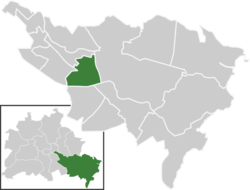Adlershof
| Adlershof | |
|---|---|
| Quarter of Berlin | |

Marktplatz (market square)
|
|
| Coordinates: 52°26′16″N 13°32′51″E / 52.43778°N 13.54750°ECoordinates: 52°26′16″N 13°32′51″E / 52.43778°N 13.54750°E | |
| Country | Germany |
| State | Berlin |
| City | Berlin |
| Borough | Treptow-Köpenick |
| Founded | 1749 |
| Area | |
| • Total | 6.11 km2 (2.36 sq mi) |
| Elevation | 34 m (112 ft) |
| Population (2008-06-30) | |
| • Total | 15,112 |
| • Density | 2,500/km2 (6,400/sq mi) |
| Time zone | CET/CEST (UTC+1/+2) |
| Postal codes | (nr. 0907) 12489 |
| Vehicle registration | B |
| Website | www |
Adlershof ("Eagle's Court") is a locality (Ortsteil) in the borough (Bezirk) Treptow-Köpenick of Berlin, Germany.
On the southwestern side of Adlershof now is built the new City of Science, Technology and Media (WISTA). The local management seeks to establish the word "Adlershof" as a synonym for WISTA, ignoring the traditional center of Adlershof.
A part of the area known today as the "City of Science, Technology and Media", was once known as the Johannisthal Air Field. Germany's first motorized aircraft took off from here at the beginning of the 20th century. Albatros, Fokker, Rumpler and Wright made Adlershof-Johannisthal famous. In 1912 the German Experimental Institute for Aviation (Deutsche Versuchsanstalt für Luftfahrt – DVL) made Adlershof its headquarters. Laboratories, motor test beds, wind tunnels and hangars were erected in the 20s and 30s and are historical landmarks today.
Adlershof is particularly well known for a series of competitions between various aviation firms' fighter aircraft designs that were held there starting in 1918. This was the first time the pilots themselves were asked for their input into the selection process; they resoundingly asked for higher speed as opposed to maneuverability, which the Idflieg had always assumed was most important.
The first of these contests, held in January 1918, led to the Fokker D.VII winning the competition and going on to become one of Germany's most feared planes. A second competition in May and June led to the acceptance of several of the main contest entries, the Pfalz D.XII, Fokker E.V, Junkers D.I and Siemens-Schuckert D.IV, the later of which is considered by many to be Germany's best design of the war. All three were put into production largely in order to make up for the slow production of the Fokkers, although only the Pfalz design could be found in any number. A final war-time contest in October was too late to have any effect on the war effort. Even after the war the process continued, with a fourth competition between February and May 1919, but the signing of the Versailles Treaty ended all military aircraft work in Germany and leading to the dissolution of the Luftstreitkräfte in May 1920.
...
Wikipedia


